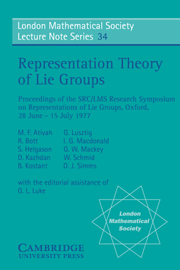Book contents
- Frontmatter
- Contents
- 1 Introduction
- PART I
- 2 Origins and early history of the theory of unitary group representations
- 3 Induced representations
- 4 The geometry and representation theory of compact Lie groups
- 5 Algebraic structure of Lie groups
- 6 Lie groups and physics
- 7 The Harish-Chandra character
- PART II
- Index
6 - Lie groups and physics
Published online by Cambridge University Press: 05 April 2013
- Frontmatter
- Contents
- 1 Introduction
- PART I
- 2 Origins and early history of the theory of unitary group representations
- 3 Induced representations
- 4 The geometry and representation theory of compact Lie groups
- 5 Algebraic structure of Lie groups
- 6 Lie groups and physics
- 7 The Harish-Chandra character
- PART II
- Index
Summary
Introduction
Lie groups play a basic role in both classical mechanics and quantum mechanics. In these lectures we shall show how symmetry in quantum mechanics leads to the study of unitary representations of Lie groups, whilst in classical mechanics symmetry leads one to investigate the action of Lie groups on symplectic manifolds. We shall see how fundamental physical quantities such as energy, linear momentum, mass and angular momentum arise naturally in this context. More briefly at the end we shall outline a quantisation procedure which enables one to pass from a classical system to its quantum analogue.
There will not, of course, be time to do more than outline the main ideas, and the bibliography at the end can be used to fill in some of the details. The basic structure of quantum mechanics and the rôle of group theory within it can be found in [5], [6], [8] and [10]. Relativistic symmetry groups are discussed in detail in the last three of these. References [6] and [8] include a discussion of internal symmetry groups. The geometric structure of classical mechanics is discussed in [5], and also in [7] and [9] where the connection with the Lie algebra dual is described. Reference [4] also contains most of the useful material on symplectic geometry which underlies classical mechanics.
- Type
- Chapter
- Information
- Representation Theory of Lie Groups , pp. 151 - 175Publisher: Cambridge University PressPrint publication year: 1980

